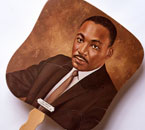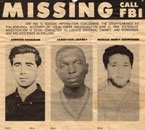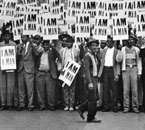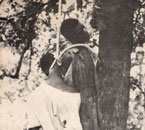Visual representations of racial murder helped convince a skeptical nation of the seriousness of the problem it faced. The use of images of atrocities against black Americans was not new to the battle against racism. The strategy dates back at least as far as the early twentieth century, with W. E. B. Du Bois’s astute and compelling publication of lynching photographs in The Crisis, and reaches its climax with Mamie Till Bradley’s courageous effort to jolt Americans out of their state of denial. Throughout the period of the civil rights movement, such imagery, intentionally or otherwise, continually reminded Americans of the tragedy and deadliness of racial hatred. It also helped alter public opinion and spurred political activism.
Image Credits/Captions (Click on thumbnails for full image)
Fan, Evans Memorial Chapel, Saginaw, Michigan, c. 1968. Offset lithograph. 12 x 7 1/2 x 1/16 in. Collection of Civil Rights Archive/CADVC-UMBC, Baltimore, MD, 2005.8
Federal Bureau of Investigation. Missing: Call FBI, June 29, 1964. Offset lithography. 15 11/16 x 10 7/16 in. International Center of Photography, Anonymous Gift, 2005. 10.2005. This poster, issued by the FBI, reports the disappearance of three activists who had traveled to Philadelphia, Mississippi in the summer of 1964 to investigate the burning of a black church. Their bodies were later found, murdered by Ku Klux Klansmen.
Ernest C. Withers. Sanitation Workers Assembling for a Solidarity March, Memphis, March 28, 1968. Gelatin silver print. 8 1/2 x 14 3/4 in. National Museum of African American History and Culture, Smithsonian Institution, Museum Purchase
I Am a Man, 1968. Offset lithography on paper. Emerson Graphics. 27 15/16 x 21 7/8 in. Collection of Civil Rights Archive/CADVC-UMBC, Baltimore, MD, 2005.160. This stark poster by Emerson Graphics in San Francisco was published shortly after the assassination of Martin Luther King, Jr. It stands as a tribute to the slain leader and a poignant reminder of the continued urgency of the struggle he died for. The poster was designed after the placards carried by black sanitation workers in the strike that brought the civil rights leader to Memphis on the day of his murder in April 1968, an event immortalized in a now iconic photograph by Ernest C. Withers.
Student Nonviolent Coordinating Committee. Otis Noel Pruitt (photograph). [Mississippi: The Lynching of Bert Moore and Dooley Morton, 1935], c. 1965. Offset lithography. 16 1/4 x 10 13/16 in. International Center of Photography, Museum Purchase. 991.2000
Bud Lee (photographer). Life, July 28, 1967. 13 11/16 x 10 9/16 in. Collection of Civil Rights Archive/CADVC-UMBC, Baltimore, MD, 2005.18. This agonizing Life cover shot depicts the nearly lifeless body of twelve-year-old Joe Bass, Jr., wounded by stray police gunfire during a riot in Newark, New Jersey, in 1967.





